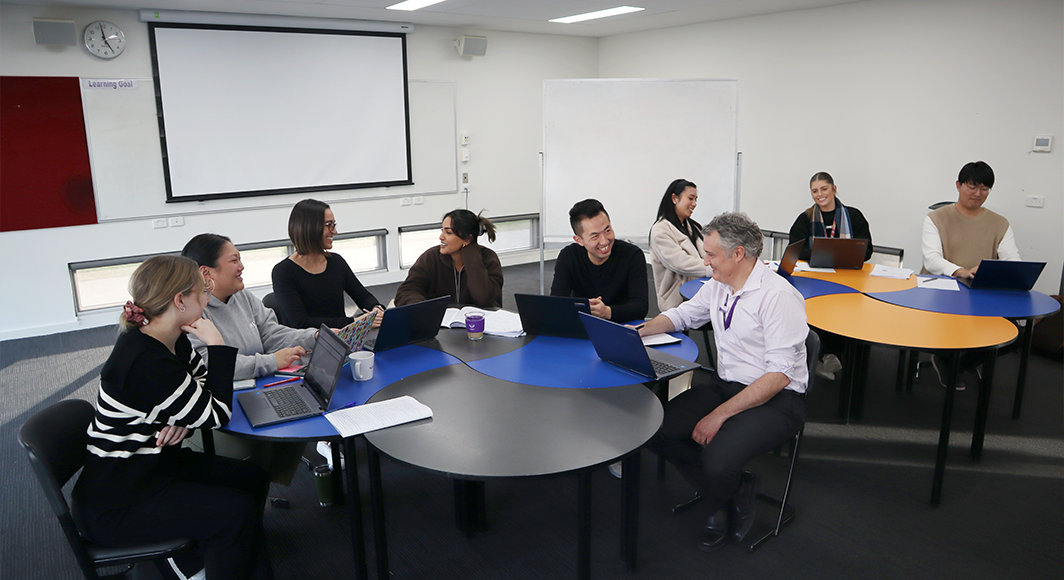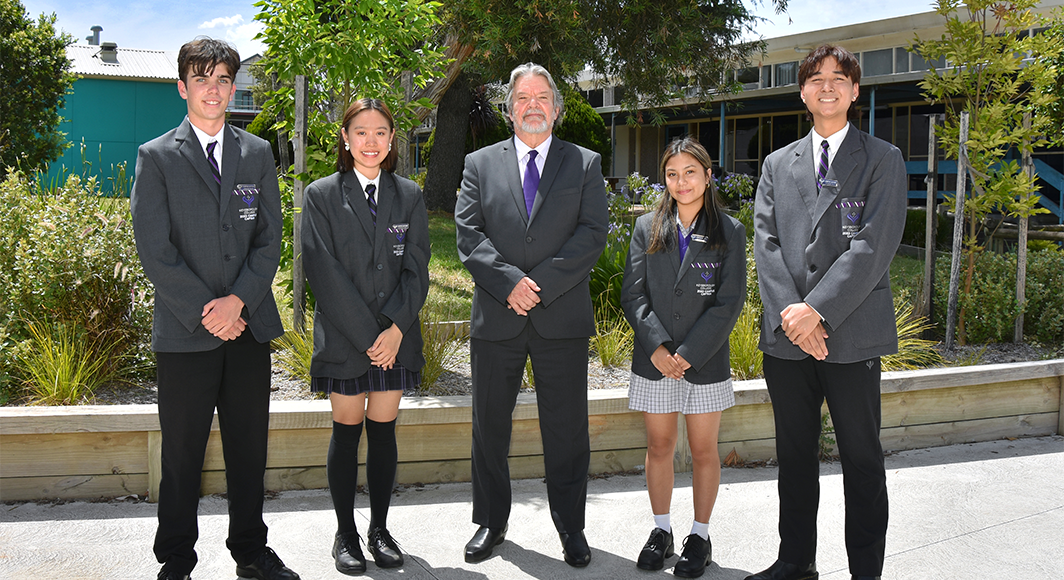Published 11 Jul 2023
Promoting teacher wellbeing and professional identity – Keysborough Secondary College
Engaged in and applied professional learning
Richard Hastings - Principal (Banksia Campus) and Erin Rabot - Assistant Principal (Teaching and Learning)
Keysborough Secondary College
Schools and early childhood services across Victoria continue to provide quality learning experiences across all levels. The VIT’s Professional Practice team is privileged to see this work first hand on visits to workplaces around the State. Here is just one example spotlighting the great work happening in a Victorian school.
Located in Melbourne’s southeast, Keysborough College offers a dynamic, vibrant learning community that encourages students to seek and embrace opportunities in a supportive environment. The college caters to individual students’ learning styles and uses a tailored approach to improve their results in the classroom.
Recently, we spoke with Campus Principal, Richard Hastings, and Assistant Principal – Teaching and Learning, Erin Rabot, about promoting teacher wellbeing and professional identity at work.
Q: Can you give some background to the development of your approach to the initiative including any research or established models / strategies that your approach is based upon?
As a leadership team, we seek to provide an induction that enables teachers to feel supported and adequately prepares them to provide quality learning experience for our students. Each year our induction process has been further refined, taking into consideration successes and areas for improvement from previous years as well as staff feedback.
A number of research models are employed to support our staff with a focus on developing professional identity and promoting staff wellbeing. These areas have been prioritised so that we can continue to build a positive workplace culture and to ensure staff are retained.
The first framework being used is the BRITE model (Building Resilience in Teacher Education). This is used to support teachers to form positive professional relationships, increase emotional awareness and manage work life balance.
The PERMAH model is also utilised to support staff in reflecting on their happiness at work and job satisfaction. It is based on positive psychology research and provides teachers with actionable ways to increase their personal wellbeing.
The use of these models is complemented by staff taking the Values in Action (VIA) character strengths survey to better understand their own ways of working and how they can best contribute to a collaborative environment.
Opportunities to develop professional identity are led by our Leading Teacher - Talent Manager Lynda Portelli. We offer optional professional learning with a specific focus on leadership. Investing in capacity building is important as we have many early career teachers.

From left teacher Melissa Sullivan, Graciella Ponce, Amy Batchelor (Learning Specialist), Sanjana Hemantharaju, Zipeng Zhang, Adam Meda, Elaine Chieu, Brittany Peach, and Dohwon Kim.
Q: What advice would you offer to other workplaces about providing support for PRTs?
The belief and philosophy of the College Leadership is that when we look at the first, second and third year teachers we can see the future of Teaching and Learning in the school. As with all good investments, the care and attention to detail taken now will pay dividends for the students of Keysborough College in the future and the longevity of our staff in their teaching careers. Don’t take short-cuts, embrace their ideas and suggestions.
A few ideas around ensuring your investment reaps the largest dividend:
- make sure that all those people supporting the PRTs are clear on their roles and it is monitored that the relationship with them and their PRT is working effectively
- make sure all documentation the PRT has to refer to is up to date
- make sure there are regular check-ins with PRTs – both formal and informal
- ensure there are opportunities to celebrate milestones in their first year
- make sure your induction program is reviewed annually using feedback from the PRTs
- the induction process must continue into their second year and even – in some format - their third year.
Q: What structural things are in place to ensure that the initiative has its best chance at success?
An induction day is held at the end of each school year before new teachers start at the beginning of the following year. The focus is on developing a sense of belonging and providing teachers with an overview of the school’s policies and protocols. The day involves learning about the school’s approach to wellbeing and being introduced to the staff handbook. There is also the opportunity to speak to a student panel to gain their perspective. Teachers are given access to the Keysborough College Teaching and Learning website on the induction day, providing them with the opportunity to explore resources over the holidays before they start.
Provisionally Registered Teachers (PRTs) are assigned both a buddy and a mentor. Buddies act as are more of a go-to for orientation and housekeeping matters (e.g. yard duty, photocopying). This allows the mentors to focus on their role in providing the PRT with a strong foundation for professional growth.
Our Campus Principals hold a check-in lunch midway through Term-1 with their inductees to gain feedback on the induction process and see how new teachers have settled. This is important to assist us to review and adjust our processes at Keysborough College and ensure that we are supporting our early career teachers as best we can.
In order to support PRTs in moving to full registration, there are a range of support sessions facilitated as part of the school professional learning schedule. This includes opportunities to develop the inquiry question and action plan, support with understanding observation protocols and assistance with finalising the inquiry and preparing for the workplace panel.
This timeline is not locked in place and is modified for the needs of each individual teacher. PRTs are encouraged to take the time that they need to develop their proficiency and experience with the Australian Professional Standards for Teachers (APST).
To enable time for providing these supports, PRTs form a discrete Professional Learning Team (PLTs). This specific professional learning program is offered throughout their first year at the school and into their second year. This is in recognition of the fact that second year teachers are still developing professionals who require ongoing support.
Erin, our AP in charge of the program, has a spreadsheet for tracking the progress of each PRT. Mentors, from her team of Specialist Teachers, have access to this and regularly update it to enable them to provide additional support if required or to adjust the professional learning schedule as needed.

John Baston with college captains of Keysborough Secondary College

Teacher Farah Mahbub standing at table with four learners at Keysborough Secondary College
Q: What are the greatest benefits to staff development of this approach?
This approach enables staff to feel valued and supported in the early stages of their career. It helps to create a sense of community and ensures teachers have a number of colleagues who they can turn to for guidance and feedback. It also provides a valuable opportunity for more experienced teachers to develop their leadership skills as they take on the mentor responsibilities.
Providing regular check-ins to support PRTs’ engagement in the Inquiry process helps to reduce teacher’s stress levels and enables them to select a focus for their inquiry that can be seamlessly integrated into their current teaching and learning practice.
The quality of submissions that are presented to the workplace panel each year continues to be outstanding. Through the inquiry process, PRTs are demonstrating their understanding of individual learning needs and developing their knowledge and application of the standards. As the induction and mentoring program has become more streamlined, we have seen greater consistency between submissions.
Q: What have been the benefits to learner outcomes of this approach? Please provide some illustrative examples if appropriate.
The thorough induction and focus on staff wellbeing ensures that students are learning from highly capable individuals who are calm, confident, and resilient. As PRTs work through the inquiry process, their students benefit from the strategies that are implemented in order to target specific areas of need.
